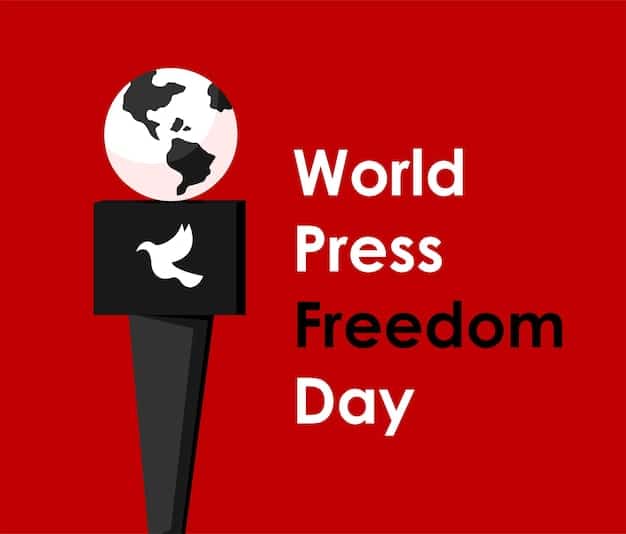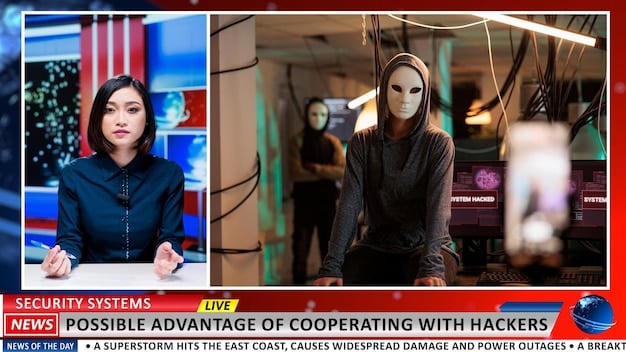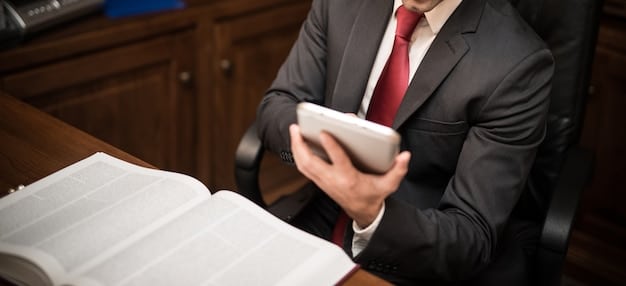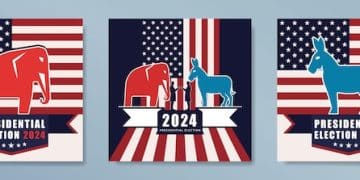Social Media Censorship: A 3-Month Analysis of Free Speech Debates

Analyzing the Impact of Social Media Censorship on Free Speech Debates: A 3-Month Review reveals how content moderation policies affect online expression, focusing on policy effectiveness, user rights, and broader implications for public discourse in the digital age.
The rise of social media has transformed how we communicate and access information, but it has also raised significant questions about content moderation and its impact on free speech. This article, Analyzing the Impact of Social Media Censorship on Free Speech Debates: A 3-Month Review, delves into the recent trends and controversies surrounding social media censorship, examining its implications for individual expression and public discourse.
Understanding Social Media Censorship
Social media censorship refers to the practice of platforms moderating, filtering, or removing content deemed inappropriate, harmful, or violating their policies. These policies can range from prohibiting hate speech and misinformation to enforcing community standards on bullying and harassment. The implementation and justification for these policies have become a hotbed for debate, with critics arguing that they can stifle free expression and disproportionately affect certain voices.
The complexity of social media censorship lies in balancing the need to protect users from harmful content with the fundamental right to free expression. While platforms have a responsibility to create safe and inclusive online environments, the line between content moderation and censorship can often be blurry.
The Evolution of Censorship Policies
Over the past decade, social media platforms have continuously refined their censorship policies in response to growing public pressure and regulatory scrutiny. Platforms like Facebook, Twitter (now X), and YouTube have invested heavily in content moderation tools and teams to identify and remove objectionable content.
Key Areas of Content Moderation
Content moderation typically focuses on several key areas, including:
- Hate Speech: Content that attacks or demeans individuals or groups based on race, ethnicity, religion, gender, sexual orientation, disability, or other protected characteristics.
- Misinformation: False or misleading information, especially when deliberately spread to deceive or manipulate public opinion.
- Violent Content: Content that promotes or glorifies violence, terrorism, or other forms of harm.
- Harassment and Bullying: Content that targets individuals with abusive, intimidating, or malicious behavior.
While the goals of content moderation are often laudable, the implementation can be fraught with challenges. Critics argue that algorithms and human moderators can be biased, leading to inconsistent enforcement and the suppression of legitimate viewpoints.

In conclusion, social media censorship is a complex issue with no easy answers. Balancing the need to protect users from harm with the right to free expression requires careful consideration and ongoing dialogue.
The First Amendment and Social Media
The First Amendment of the U.S. Constitution protects freedom of speech, but its application to social media platforms is not straightforward. As private companies, social media platforms are not directly bound by the First Amendment. However, the question of whether they should be treated as public forums, subject to similar free speech protections, has been a subject of intense debate.
The debate often revolves around the concept of “state action,” which refers to government conduct that triggers First Amendment protections. While private actors are generally not subject to the First Amendment, their actions can be considered state action if they are closely intertwined with government entities or functions.
Arguments for Applying First Amendment Principles
Some argue that social media platforms have become so essential to modern communication that they should be considered akin to public squares. They contend that platforms wield significant power over public discourse and should be held accountable for upholding free speech principles.
Arguments Against Applying First Amendment Principles
Others argue that forcing social media platforms to adhere to First Amendment principles would infringe on their own free speech rights. They assert that platforms have the right to curate content and establish their own community standards, even if those standards restrict certain types of expression.
- Private vs. Public Forums: The legal distinction between private and public forums is central to the debate.
- Platform Responsibility: The extent to which platforms should be responsible for the content posted by their users remains a contested issue.
- Government Regulation: The potential for government regulation of social media platforms raises concerns about censorship and political interference.

The legal landscape surrounding social media and the First Amendment is constantly evolving, with courts grappling with novel questions about the scope of free speech in the digital age. It is clear that these debates will continue to shape the future of online expression.
The Impact on Political Discourse
Social media censorship has had a profound impact on political discourse, raising concerns about bias, manipulation, and the suppression of dissenting viewpoints. Critics argue that platforms have disproportionately targeted conservative voices, while supporters contend that they are simply enforcing their policies against hate speech and misinformation.
The debate over political bias in social media censorship has intensified in recent years, with accusations of “shadow banning,” algorithmic manipulation, and selective enforcement of policies. These accusations have fueled distrust in platforms and contributed to a polarized political climate.
Examples of Controversial Censorship Decisions
Several high-profile censorship decisions have sparked outrage and controversy, including:
The Role of Algorithms
Algorithms play a crucial role in determining what content users see on social media platforms. These algorithms can amplify certain voices and suppress others, raising concerns about algorithmic bias and manipulation.
- Algorithmic Transparency: Critics call for greater transparency in how algorithms are designed and implemented.
- User Control: Some advocate for giving users more control over their own feeds and the content they see.
- Independent Audits: Proposals for independent audits of social media algorithms aim to ensure fairness and impartiality.
The impact of social media censorship on political discourse is undeniable. As platforms continue to grapple with these challenges, it is crucial to foster open dialogue and explore solutions that protect both free speech and the integrity of the democratic process.
Censorship and Misinformation
One of the primary justifications for social media censorship is the need to combat misinformation, which can have serious consequences for public health, safety, and democratic institutions. However, the line between legitimate efforts to curb misinformation and censorship can be blurry.
The spread of misinformation on social media has become a major concern, particularly during times of crisis, such as the COVID-19 pandemic. False or misleading information can undermine public trust in institutions, discourage healthy behaviors, and even incite violence.
The Challenge of Identifying Misinformation
Identifying misinformation is a complex task, often requiring expertise in specific fields and the ability to distinguish between credible and unreliable sources. Social media platforms have struggled to develop effective strategies for addressing this challenge.
Strategies for Combating Misinformation
Social media platforms have employed a variety of strategies to combat misinformation, including:
- Fact-Checking Partnerships: Partnering with independent fact-checkers to identify and label false or misleading content.
- Content Warnings: Adding warnings or disclaimers to content that may contain misinformation.
- Account Suspensions: Suspending or banning accounts that repeatedly spread misinformation.
The fight against misinformation is an ongoing battle. As technology evolves and new forms of misinformation emerge, social media platforms will need to adapt their strategies and collaborate with experts to ensure that users have access to accurate and reliable information.
The User Perspective
The impact of social media censorship on users varies widely depending on their beliefs, values, and experiences. Some users welcome content moderation as a way to create safer and more inclusive online environments, while others view it as a form of censorship that stifles free expression. This section examines various user perspectives to better understand the complexity surrounding social media censorship.
User experience is pivotal when determining the efficacy of content moderation policies. How users perceive these policies significantly influences their engagement and trust in the platform.
Surveys and Studies
Several surveys and studies have attempted to gauge user attitudes toward social media censorship. These studies reveal a wide range of opinions, with some users expressing support for content moderation and others expressing concern about its potential impact on free speech.
Anecdotal Evidence
Anecdotal evidence also provides valuable insights into user experiences with social media censorship. Personal stories and testimonials can shed light on how content moderation policies affect individuals and communities.
- Personal narratives: Accounts from users who feel silenced or unfairly targeted by censorship policies.
- Community impact: Observations on how content moderation affects the dynamics within online communities.
- Platform perceptions: Insights into how different platforms are perceived based on their moderation practices.
Ultimately, understanding the user perspective is essential for developing content moderation policies that are both effective and respectful of free speech principles. By listening to user feedback and engaging in open dialogue, social media platforms can create online environments that are both safe and inclusive.
Moving Forward
As the debate over social media censorship continues, it is imperative to explore pathways toward more transparent, accountable, and equitable content moderation practices. There is no one-size-fits-all solution, but a combination of technological advancements, policy reforms, and user empowerment initiatives can help to strike a better balance between protecting users from harm and safeguarding free speech.
The future of social media censorship will likely involve a multi-faceted approach that takes into account the diverse needs and perspectives of users, policymakers, and platform operators. The goal should be to create online environments that are both safe and conducive to open dialogue.
Potential Solutions
Several potential solutions have been proposed to address the challenges of social media censorship, including:
The Importance of Dialogue
Ultimately, the success of any approach to social media censorship will depend on fostering open dialogue and collaboration among all stakeholders. By engaging in constructive conversations and exploring common ground, we can work toward creating online environments that promote both free speech and responsible content moderation.
| Key Point | Brief Description |
|---|---|
| ⚖️ First Amendment | Discusses its relevance on social platforms. |
| 📢 Political Bias | Concerns about censorship and unfair practices. |
| 🌐 Misinformation | Examining methods to combat false information. |
| 🧑🤝🧑 User Perspectives | Understanding diverse views and experiences. |
Frequently Asked Questions
▼
Social media censorship refers to how platforms moderate content, filtering or removing what they deem harmful, with policies addressing hate speech, misinformation, and harassment.
▼
While the platforms aren’t directly bound by the First Amendment, discussions revolve around whether they should act as public forums, offering similar free speech protection.
▼
Accusations of bias include conservatives claiming to be unfairly targeted, while some suggest moderation is a necessary action to eliminate hate speech.
▼
Platforms are employing fact-checking, content warnings, and account suspensions to combat misinformation. In doing so, these methods aim to reduce false information online.
▼
Proposed actions include more algorithmic transparency, increased user control, and independent audits to build fairer, more open practices.
Conclusion
Analyzing the impact of social media censorship on free speech debates reveals a complex interplay between user rights, platform responsibilities, and public discourse. By encouraging open dialogue, supporting innovative solutions, and prioritizing user empowerment, we can work towards a digital future where freedom of expression and responsible online behavior coexist.





